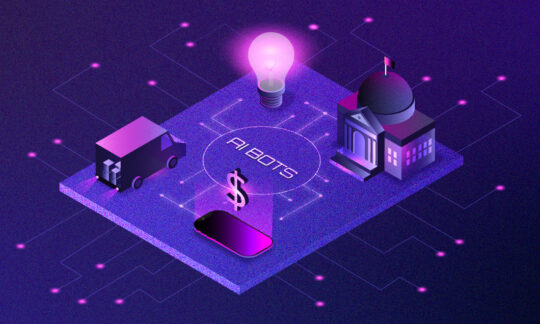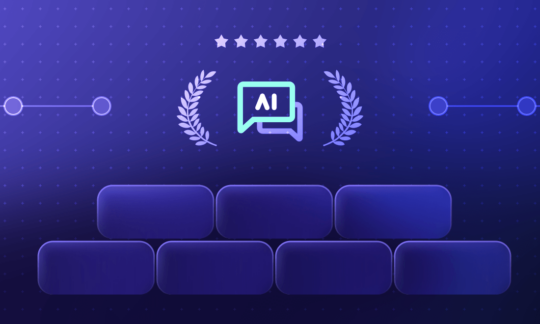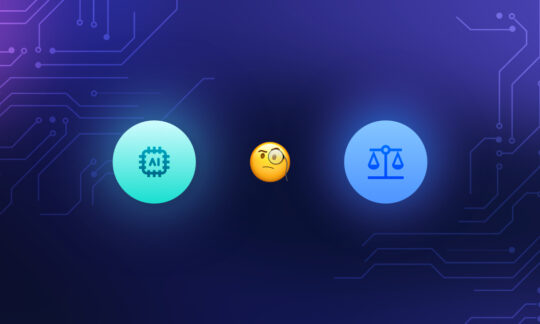Exploring Webchat Bots for Your Website
Table of contents
- What Is a Chatbot?
- What Is Webchat?
- AI Chatbots vs. Rule-Based Chatbots
- Webchat Chatbots Use Cases
- Benefits of Using Webchat Bots for Business
- How to Create a Simple Webchat Chatbot
- Why You May Need AI Chatbots Instead of Rule-Based Chatbots
- Webchat Chatbots Best Practices
- Webchat Chatbots Examples
- Choose the Right Chatbot for Your Business
What Is a Chatbot?
In simple terms, a chatbot is a software application designed to interpret and respond to questions or requests from humans. But not all chatbots are alike. Some are limited to a basic command-and-response pattern, while others have sophisticated abilities to process language and provide unique answers. In this post, we’ll explore the different types of chatbots available, and examine how they can be applied as webchat bots on a company’s website.
What Is Webchat?
Webchat is the method that most people use to interact with a chatbot. On websites, they often appear as modular chat windows on a corner of the screen. Sometimes referred to as a virtual assistant, webchat is the interface for visitors to ask questions, and for the chatbot to deliver responses. While this post primarily focuses on webchat appearing on a company’s website, the same chatbot capabilities can support customers through other digital channels such as social media, messenger apps, and voice-activated devices.
AI Chatbots vs. Rule-Based Chatbots
The most important distinction between chatbot types is whether it is rule-based or AI-enabled. Rule-based chatbots have a limited set of unchanging responses based on fairly simple logic. Like phone-based IVR systems, these chatbots allow people to choose an option, which then generates either a refined set of options or a predetermined response. Some rule-based chatbots allow people to use free-form text, but the logic of the chatbot is limited to selecting keywords from it and matching the keywords to a limited set of responses.
AI chatbots and voicebots, such as those provided by SentiOne, are powered by artificial intelligence. The sophisticated technology of AI-powered chatbots can enhance the user experience significantly. For starters, natural language processing (NLP) capabilities allow the chatbot to interpret the intent and meaning of a chat response. Once that intent is understood, the chatbot uses complex processing capabilities to choose the most likely resolution or response. Because it is not limited to simple “if X, then Y” logic, an AI-enabled chatbot has unlimited response options. Another important aspect of AI is self-learning, the ability to improve response accuracy over time as the chatbot gathers more data from previous interactions.
Webchat Chatbots Use Cases
The range of web chat bot applications in business is broad, and expanding rapidly as capabilities evolve. Let’s look at some of the more practical, customer-service-intensive functions that chatbots are handling today across all types of industries.
- Answering common customer questions: Most call centers are subject to an 80/20 rule where the vast majority of calls are on specific issues. Chatbots can be trained to handle these high-volume inquiries. They can surface helpful information, often buried deep within the website, to address common questions. When integrated with CRM or other back-end systems, they can also help troubleshoot account-specific inquiries.
- Resolving complaints: Many businesses have specific procedures for logging and responding to customer complaints. Chatbots can be trained to handle these, including understanding the appropriate cues to get a customer service rep engaged.
- Accepting payments: Billing and balance inquiries are common across most industries, and chatbots can facilitate the appropriate responses, including support for digital payment capabilities.
- Forms or procedures: Chatbots can direct customers to the right forms or workflows to achieve their task successfully, resulting in reduced effort for the customer and less error handling by staff.
- Scheduling or reservations: Chatbots can connect with many types of reservation or scheduling systems, making it easy for customers to book an appointment.
- Tracking an item: Many customers simply want a status update, and chatbots can access the appropriate data and surface that for the customer.
- Service alerts or updates: Customers won’t always search and find information that is relevant to them. A chatbot can relay time-sensitive information that is meaningful to the customer’s services.
- Promotions, rebates, offers: Chatbots can be programmed to determine if a customer is eligible for special promotions or offers and share information on these campaigns.
Benefits of Using Webchat Bots for Business
Webchat bots are proving vastly more effective and efficient than traditional IVR phone support or live chat with a human operator. According to Gartner, organizations report a reduction of up to 70 percent in call, chat, and email inquiries after implementing a chatbot. Companies have found that not only can a chatbot drastically reduce call or email volume, it can resolve issues faster. A study published in the MIT Technology Review revealed that 90% of respondents reported measurable improvements in the speed of complaint resolution.
What do these studies mean in terms of meaningful business metrics? Here’s just a few to consider:
- Reduced operating costs: Chatbots can significantly reduce the expense of call center staffing and training. By handling common, repetitive customer inquiries, chatbots can free up skilled staff members to go above and beyond to achieve new customer satisfaction levels.
- Client satisfaction: Most customers aren’t reaching out unless they have a problem. Based on prior experiences, they may anticipate a long wait for customer support. Having their issue resolved quickly and efficiently by a chatbot can create a positive brand experience.
- Availability: Customers increasingly expect round-the-clock support. One study found that 43% of retail consumers expect 24/7 support from e-commerce businesses. Regardless of your industry, you can either meet these expectations or wow your customer with the always-on support from a live webchat bot.
How to Create a Simple Webchat Chatbot
Setting up a rule-based chatbot can be a fast and relatively simple process. But before pursuing that route, you’ll want to consider the limitations of a purely rule-based bot. The linear and limited logic of a task-based bot might suit many small businesses, but at the enterprise level, leaders are investing in AI. In fact, a study conducted by The AI Journal found that 72% of business leaders feel positive about the role that AI will play in the future.
To create a rule-based chatbot, begin by thinking of common inquiries from your customers, then convert them to questions. Assign appropriate script responses to the questions. For a multi-step support process, create a decision tree that maps the various paths and options. To implement, you can build your own with popular chatbot toolsets such as Microsoft’s Azure Bot Services, or choose one of the many commercial solutions available. Most rule-based chatbot platforms will have an easy-to-use interface allowing you to map the responses without touching the underlying code.
Why You May Need AI Chatbots Instead of Rule-Based Chatbots
While rule-based chatbots are affordable and can be easy to implement, enterprise leaders need to carefully consider which type of chatbot can meet the needs of their digital strategy and customer engagement goals. The risk of choosing wrong has higher stakes than one unsatisfactory chatbot experience by a customer – it can cause customers to refuse to engage with your chatbot for years to come.
Cons of rule-based chatbots
There are some significant limitations of rule-based chatbots to bear in mind:
- Potential misinterpretation: Rule-based bots do not have natural language processing capabilities and therefore cannot handle more complex requests involving multiple variables. They can be trained to respond to certain keywords, but may be using a keyword in a way that is mismatched with customer intent.
- Limited responses: Rule-based bots have a predetermined set of answers. This can be unsatisfying for customers, resulting in more handoffs to live representatives.
- Lack of self-learning: Rule-based chatbots lack the “brain” of AI systems. They follow rules faithfully but do not have processes to assess and optimize in order to continuously improve responses as AI chatbots do.
In short, it’s a predesigned journey and doesn’t provide your customer with as many self-service options.
The Benefits of AI-Enabled Chatbots
Artificial intelligence enables some powerful capabilities employed by sophisticated chatbots. Conversational AI systems use natural language processing (NLP). NLP involves two key components:
- Natural language understanding (NLU): NLU is the intelligence layer that works to understand your customers and the intent of their messages. NLU capabilities can be constantly improved by adding industry-specific intelligence or training data from your organization.
- Natural language generation (NLG): NLG is the software component that generates understandable text in human languages. It contains the rules for discourse, lexicon, syntax, punctuation, etc.
When you enter text into an NLP-enabled chatbot, the meaning of the message is determined by the NLU, and the response is created by the NLG.
Through these capabilities, AI-enabled chatbots can generate more meaningful conversations, solve more complex problems, and provide a more rewarding experience for your customers.
Webchat Chatbots Best Practices
Unlike some projects involving complex technology, webchat chatbots can be surprisingly easy to design and launch. Before you rush in, consider these best practices:
- Start with strategic alignment: What strategic problems can a chatbot solve for your enterprise? What goals and metrics can it help improve? Setting initial goals and targets allows you to get buy-in and maintain focus.
- Assess digital channels and integrations: Chatbots can reach deep into your organization’s CRM or contact center platform. They can also integrate with other digital channels like messenger apps, social media, or voice devices.
- Dedicate resources to ongoing optimization: While chatbots have powerful out-of-the-box capabilities, the best experiences arise when companies are committed to continuously training and educating the chatbot for improvement.
- Aim for low-hanging fruit: The majority of customer issues typically revolve around a few common tasks that can be automated with a chatbot. Start with those as your quick wins.
- Consider the human touch: Depending on your business, there may be sensitive topics or customers that warrant dedicated support from specialized staff. Map out those scenarios and design processes for an appropriate handoff.
Webchat Chatbots Examples
If you’ve interacted with Siri, Alexa, or Google Assistant, then you’re already familiar with a conversational AI chatbot. Webchat chatbots exist across a variety of business industries. Here are some examples:
- Bank of America launched Erica in 2018. The conversational AI chatbot has helped 32 million customers with over 1 billion interactions.
- Marriott uses their chatbot, ChatBotlr, to enable guests to make service requests from their smartphones. The company’s Aloft Hotels brand reports that 2 out of 3 guests are interacting or making requests with ChatBotlr.
- Sephora has chatbot capabilities to allow customers to make appointments with beauty specialists, or use augmented reality to help customers pick and match colors.
- Pizza Hut launched a conversational chatbot on Facebook and Messenger. The bot can handle pizza and other food delivery orders.
Choose the Right Chatbot for Your Business
SentiOne’s conversational AI chatbot has achieved 94% intent accuracy recognition due to a natural language engine that comes pre-trained with more than 30 billion online conversations. To learn more, visit the SentiOne website or book a demo for a first-hand look.



